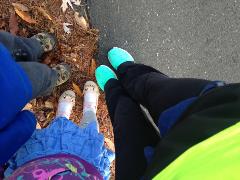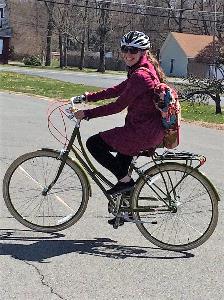Melissa W. Roti, Ph.D., FACSM, ACSM-EP, GEI |
Aug.
14, 2018
It is back-to-school time and this often means a new schedule and more small trips, especially with children. This is also a good time of year to establish new routines like using active transportation, which has many co-benefits including improved physical and mental health as well as environmental and economic savings. Incorporating active transportation with kids and around their schedules can be a wonderful opportunity to role model healthy living. As health professionals, we want to promote all types of physical activity, and active transportation can help prevent climate change, too. This can be a more challenging behavior for some, but it does not have to be all or none. It may take a while to gradually increase your participation in active transportation, but starting small can help you add a new behavior.
 Here are some strategies you can use to begin incorporating active transportation into your daily life with children (or furry ones):
Here are some strategies you can use to begin incorporating active transportation into your daily life with children (or furry ones):
- Walk/bike with kids to school. (Safe Routes to School)
- Weekend errands/outings.
- Drive child to lessons and park car; walk to errands from there.
- Start with shorter walkable distances then progress to bicycling if desired or try other human-powered modes such as scooters, skateboards, or roller blades.
- Many businesses are dog friendly —walk your dog to get morning coffee. ("Dog Walking is Good for You", NYT 2018)
Work-related/on your own strategies:
- “Free Ride Fridays” Emission-free bike/walk to work. Fridays tend to be a bit more relaxed in relation to schedule and dress codes.
- Drive most of the distance of a trip, then park and walk/bike last mile (or half mile or two miles).
- From work, walk to lunch or errands during the day as you may be closer to resources near work than at home.
- Ride/walk to fitness center, park, other physical activity —no worries about being sweaty (I regularly ride to yoga).
- Consider practicing walking or bicycling a route at a quieter time of day/week when there is less time pressure to determine best commuting time and route.
 The type of active transportation may vary with lifestyle/family. Before children, I rode my bicycle for most errands in town (supermarket, farmers market, pharmacy, bank, cafes) and commuted to work 1-2 days per week in fair weather. With young kids, I pulled them along in a bike trailer. Now with older kids, we will ride together for errands, to the park (or to get ice cream!) or will walk to school. My community does not have many sidewalks, so it has meant waiting until my children were old enough to properly navigate our winding rural roads. Advocating for walking and bicycling infrastructure (sidewalks, crosswalks, protected bike lanes, etc.) will increase safety, accessibility and convenience, so attend your local planning and zoning committee meetings. Take any opportunity to prevent further climate change and protect our health by incorporating active transportation, even in small steps.
The type of active transportation may vary with lifestyle/family. Before children, I rode my bicycle for most errands in town (supermarket, farmers market, pharmacy, bank, cafes) and commuted to work 1-2 days per week in fair weather. With young kids, I pulled them along in a bike trailer. Now with older kids, we will ride together for errands, to the park (or to get ice cream!) or will walk to school. My community does not have many sidewalks, so it has meant waiting until my children were old enough to properly navigate our winding rural roads. Advocating for walking and bicycling infrastructure (sidewalks, crosswalks, protected bike lanes, etc.) will increase safety, accessibility and convenience, so attend your local planning and zoning committee meetings. Take any opportunity to prevent further climate change and protect our health by incorporating active transportation, even in small steps.
Check out ACSM’s “Getting Started With Cycling” info sheet for help selecting a bike, helmet, and clothing that will lead to a more enjoyable and successful trip.
Want more information on walking and biking for transportation and how it benefits health, helps mitigate climate change, and boosts the economy? Explore resources and webinars on the ActivEarth webpage.
Melissa W. Roti, Ph.D., FACSM, ACSM-EP, GEI
Professor, Director Exercise Science Program
Westfield State University
Member, ActivEarth Task Force
On Twitter: @MelissaRoti